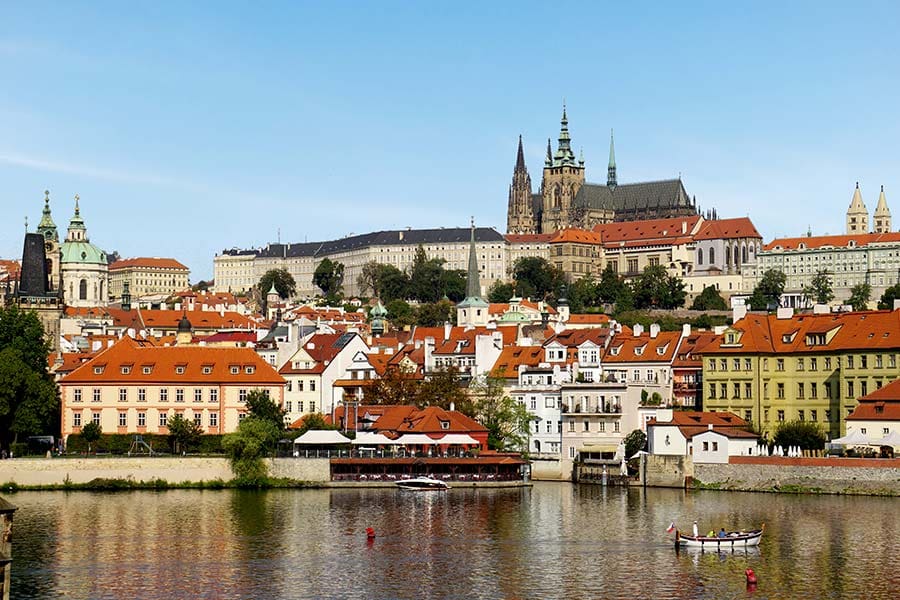
By Mary Ann DeSantis
Near & Far: Panoramic Prague

The 10th-century castle and towers in Prague, Czech Republic, have withstood the test of time and served as extraordinary backdrops for remarkable changes in the city.
Photos: Tony and Mary Ann DeSantis
In every direction, a postcard-like view reveals itself in Prague’s Old Town and other districts. Well, almost a postcard view. In 2018, Prague experienced a crush of tourists, and it is impossible to take photos without throngs of people in every frame. Even at 5am, hordes of photographers, both amateur and professional, are on the iconic Charles Bridge waiting for the perfect sunrise shot.
“During Communist times, 1 million visitors a year came to Prague; now it’s 1 million a month,” my airport shuttle driver says with slight exaggeration. The city of Prague’s annual tourism report put the official number at 3,528,864 visitors in 2017. I could believe it as I jostled for a spot on the bridge overlooking the Vltava River to take a panoramic picture.

Old Town Bridge Tower
Because of the well-preserved medieval architecture, the city has become a destination for weddings, a setting for magazine covers, and a backdrop for numerous movies, including Tom Cruise’s first “Mission Impossible,” “The Illusionist,” and, most recently, “The Zookeeper’s Wife.”
I knew I was visiting Prague at the height of tourist season (late summer), but that didn’t deter me. After finishing a Viking River Cruise along the Danube, I was too close to the city to skip it, and a whirlwind tour would be better than not seeing it at all. After all, I had a personal connection to the city through my maternal grandfather.
My grandfather’s 1922 Czechoslovakian passport shows a stamp that he was leaving Prague for America. I always knew he was from Czechoslovakia, the Communist-era name of the country that combined both the Czech Republic and Slovakia for 40 years. Although he grew up in Slovakia, his last stop in central Europe was Prague, and the city’s grandeur was etched in his mind.
This year, the Czech Republic is celebrating the 100th anniversary of its founding following World War I. Prague is filled with commemorations marking the country’s centennial as well as next year’s 30th anniversary of the dissolution of the Soviet Bloc. From 1948 to 1989, the Czechs were under communist rule, but today they have found “joie de vie,” or joyful life, as an invasion of tourists is shaping the city more than ever.

John Lennon Graffiti Wall
Entire books have been written about Prague’s many illustrious sights. Among my favorites were the John Lennon Graffiti Wall near the French Embassy and Wallenstein Garden in the Malá Strana. The graffiti wall is a memorial to the former Beatle who was a pacifist hero to the Czechs—much to the chagrin of the in-power Soviets in 1980. I found some respite in Wallenstein Garden on a brutally hot afternoon after a full morning of sightseeing. I also came to better understand the country’s tangled history through a modern timeline displayed for the centennial in one corner of the garden.
Later, as I walked along the pedestrian-only Charles Bridge and under the Old Town Tower, I thought about how that gothic gateway loomed over my grandfather as he prepared to leave his homeland at age 17. And then it occurred to me that the tower also looked the same in the 14th century when Emperor Charles IV commissioned the bridge.

St. John of Nepomuk
It’s easy to lose track of time on the Charles Bridge with so many Czech artists, all approved by the city, selling their works. Several of the bronze statues are also worth a closer look. The most striking was St. John of Nepomuk, a 14th-century priest who was thrown from the bridge because he wouldn’t reveal secrets he heard during confessions, especially those of the queen. The five golden stars encircling his head represent the stars that appeared when he hit the water and signify his purity. The legend says if you rub the statue’s bronze plaque, you will return to Prague someday. I rubbed it twice because there is so much more I want to see.

Wallenstein Garden
Know before you go
- Prague is a very walkable city but be prepared for the cobblestone streets with sturdy walking shoes. Also, the public transportation system is one of Europe’s best. Take the metro for fast service or a tram for a cultural experience.
- Prague is divided into four parts: Old Town, New Town (actually founded in 1438), Castle District (Hradčany), and Little Quarter (Malá Strana). If your time is limited, decide on the sights of most interest to you and stay in that area. We chose the Castle District because we knew we wanted to spend time there.
- Money exchange and credit cards became a bit of an issue for us. We took a few Czech koruna (Kč) and planned to use credit cards for most purchases. That plan failed the first day. Most restaurants and small shops do not take credit cards unless you spend a large amount, so we quickly went through the local currency and had a hard time finding ATM machines. We learned most vendors now take euros, and some even preferred euros.
- Trams Nos. 22 or 23 go to the Castle District. Of course, you can walk, but it’s an uphill climb. You will need your energy because the Castle—the region’s seat of power for more than 1,000 years—is worth a day trip in itself with several museums, St. Vitus Cathedral, and the Royal Palace and Gardens.

St. Vitus Cathedral
A momentous number
Prague’s history is inescapable even to everyday tourists. As I toured, knowing some of that history helped to understand the culture. And as surreal as it sounds, the most significant events occurred in years ending with the numeral 8:
1918: The country became an independent republic following World War I when it broke free of the Austrian-Hungarian Empire.
1938: The Nazi regime marched in and took away freedom in a blink of an eye.
1948: The Soviet Bloc was established, and the Communists ruled for the next 40 years.
1968: The “Prague Spring” uprising occurred when Soviet troops arrived in Czechoslovakia to quell the growing movement of liberalization.
1988: The threads on the Velvet Curtain began to fray; by 1989, the Soviets left and the Czech Republic reemerged.































